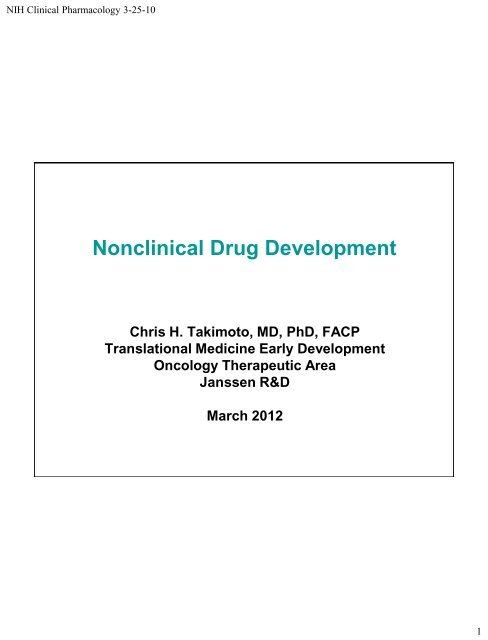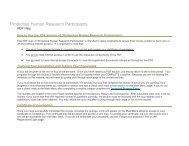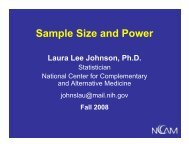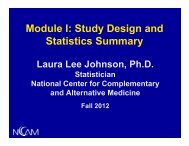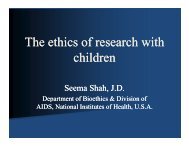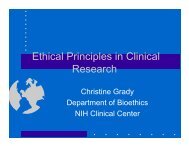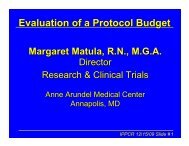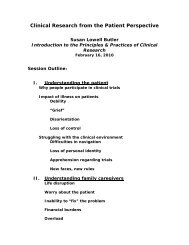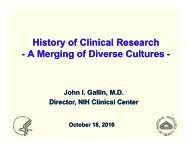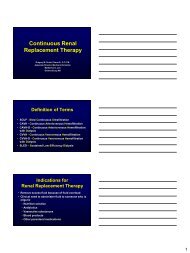Pre-clinical drug development_1slide
Pre-clinical drug development_1slide
Pre-clinical drug development_1slide
You also want an ePaper? Increase the reach of your titles
YUMPU automatically turns print PDFs into web optimized ePapers that Google loves.
NIH Clinical Pharmacology 3-25-10Non<strong>clinical</strong> Drug DevelopmentChris H. Takimoto, MD, PhD, FACPTranslational Medicine Early DevelopmentOncology Therapeutic AreaJanssen R&DMarch 20121
NIH Clinical Pharmacology 3-25-10Disclosure InformationChris H. Takimoto, MD, PhD• Employment: Janssen R&D/Johnson & Johnson• Stock: Johnson & Johnson• Off Label Use: I will not discuss off label use of anyproducts2
NIH Clinical Pharmacology 3-25-10Lecture Outline• Non<strong>clinical</strong> Drug Development Definitions & Scope• Components of Non<strong>clinical</strong> Drug Development– Pharmacology Studies– Safety Pharmacology– PK/ADME Studies– Toxicology– Starting Dose Selection and Study Desgin Issues for FIH• Non<strong>clinical</strong> Translational Research Strategies– Targeted therapies/Biomarkers– Pharmacological Audit Trail/Model-based <strong>drug</strong> <strong>development</strong>– Translational <strong>clinical</strong> <strong>development</strong> plans3
NIH Clinical Pharmacology 3-25-10Non<strong>clinical</strong> Drug DevelopmentAn Industrial PerspectiveTarget ID/ValidationDiscoveryNMEDeclarationEarlyDevelopment-- Kramer et al Nat Rev Drug Disc 20075
NIH Clinical Pharmacology 3-25-106
NIH Clinical Pharmacology 3-25-10Components of Non<strong>clinical</strong> DrugDevelopment• Pharmacology Studies/Model Selection• Safety Pharmacology• PK/ADME Studies• Toxicology• Starting Dose Selection and study designissues for FIH7
NIH Clinical Pharmacology 3-25-10S9 Oncology Specific Guidance• Applies to targeted small molecules andbiopharmaceuticals used for treating “patients withadvanced disease and limited therapeutic options”– Advanced cancer is a progressive, fatal disease– Existing therapies have limited effectiveness– Treatment at or close to adverse effect dose levels• Type, timing, and flexibility of oncology studies maydiffer from other therapeutic areas• Does NOT apply to cancer prevention, supportivecare, healthy volunteers, radiopharmaceuticals,vaccines, cellular or gene therapies-- S9 Guidance for Industry, 20108
NIH Clinical Pharmacology 3-25-10S9 Oncology Specific GuidanceGoals of Non<strong>clinical</strong> Testing1. Identify the pharmacologic properties of apharmaceutical2. Understand the toxicological profile of apharmaceutical3. Establish a safe initial dose level of the firsthuman exposure-- S9 Guidance for Industry, 20109
NIH Clinical Pharmacology 3-25-10Non<strong>clinical</strong> Drug DevelopmentIn Vitro Pharmacology Models• In vitro studies performed in cell lines or cellfreesystems– Often form the basis for screening andoptimization during discovery• Oncology uses human tumor cell lines forevaluation of:– Mechanism of action– Evaluation of potency and selectivity– Early indication selection– <strong>Pre</strong>dictive biomarker discovery10
NIH Clinical Pharmacology 3-25-10In Vitro Cell Line AnalysesCisplatinCarboplatinCellLinesRelative Potency (GI 50 )11
NIH Clinical Pharmacology 3-25-10Limitations of 2D Tumor ModelsTumor Microenvironment-- Pollard, Nat Rev Cancer, 200812
NIH Clinical Pharmacology 3-25-10Humanized 3D Models(for Advanced Biomarker and Drug Discovery Applications)Abbreviations: TGA, tumor growth assay; IrBME, Irradiated basement membrane extract; hMSC, humanmesenchymal stem cells; hCAF, human cancer associated fibroblasts; TME, tumor microenviroment-- B. Hall, Janssen R&D13
NIH Clinical Pharmacology 3-25-103D-TGA: Diverse Biologic ApplicationsSasser, et al. 2007 Cancer Letts; Sasser, et al 2007 FASEB J, Studebaker, et al. 2008 Cancer Res; Spaeth, et al. 2009 PLoS One; Sullivan, et al. 2009 Oncogene-- B. Hall, Ortho Biotech Oncol R&D14
NIH Clinical Pharmacology 3-25-10In Vivo Animal Models• The ideal animal model should be:– Valid– Selective– <strong>Pre</strong>dictable– Reproducible“There is no perfect tumor model”“All models are wrong, some are useful”15
NIH Clinical Pharmacology 3-25-10Endostatin: An Endogenous Inhibitor ofAngiogenesis and Tumor GrowthO'Reilly et al, Cell 88:277-285 (1997)16
NIH Clinical Pharmacology 3-25-10In Vivo Efficacy Models in Cancer• Spontaneous tumors– Idiopathic– Carcinogen-induced– Transgenic/gene knockout animals: p53, RB, etc• Transplanted tumors– Syngeneic animal tumors: Lewis lung, S180sarcoma, B16 melanoma murine tumors– Human tumors growing in vivo in implantablehollow fibers17
NIH Clinical Pharmacology 3-25-10Human Tumor Xenografts Models• Most common in vivo pre<strong>clinical</strong> efficacymodels in oncology– Current NCI standard in vivo efficacy testingsystem• Consist of human tumor cells implanted inimmunocompromised animals– Nude mice– SCID mice– Nude rats• Diverse human tumor cell lines propagated invitro can grow as xenograft models18
NIH Clinical Pharmacology 3-25-10Nude Mouse Hosts for XenograftStudies• Athymic “nude” mice developed in 1960’s• Mutation in nu gene on chromosome 11• Phenotype: retarded growth, low fertility, nofur, immunocompromised– Lack thymus gland, T-cell immunity• First human tumor xenograft of colonadenocarcinoma by Rygaard & Poulson,196919
NIH Clinical Pharmacology 3-25-10Differential Tumor Growth ofProstate Cancer Xenograftsn = 10NogrowthRapidgrowth(Mahajan, Cancer Res 2005;65:10514)20
NIH Clinical Pharmacology 3-25-10Xenograft Advantages• Diverse selection of different human tumor types– Molecular characterization, GEP, available in public databases• Ease and speed of start up and conduct of studies• Simultaneous evaluation of safety and efficacy (therapeuticindex)• Some correlation with <strong>clinical</strong> activity lung, colon, breast, andmelanoma cancers• Although subcutaneous implantation is most common,orthotopic injections are possible– Mammary fat pad, CNS, intraperitoneal, etc• Wide accessibility• Many decades of experience21
NIH Clinical Pharmacology 3-25-10Xenograft Disadvantages• Atypical biological behavior– Metastases are rare– Survival not an ideal endpoint, with historical deaths from tumorbulk, not invasion– Short doubling times– Less necrosis, better blood supply• Positive predictive value is poor• Poorly mimics the tumor microenvironment– Human tumor cells with murine stroma– Host directed therapies (immunomodulation, stromal tissuetargets) may not be applicable• Species specific differences between humans and mice– Examples: Antibody biopharmaceutics that only recognizehuman targets22
NIH Clinical Pharmacology 3-25-10Low Passage Patient TumorgraftsPrimary human tumors•Primary--R. A. Weinberg, in The Biology of Cancer, 2007(Courtesy of W. Hait)23
NIH Clinical Pharmacology 3-25-10Patient Tumorgraft ClinicalCorrelationsColorectal Tumorgraft(Estrada et al, EORTC-NCI-AACR, 2010)Myoepithelial Salivary GlandTumorgraftSubcutaneous ImplantSalivary Metastases(Courtesy of M. Wick, START Laboratories)24
NIH Clinical Pharmacology 3-25-10Transgenic Animal Models of Cancer• p53 or other tumor suppressor gene knockout animalshave high incidence of endogenous tumor <strong>development</strong>• Theoretically more directly analogous to human situation• Advantages– Intact immune system– Murine tumor and stroma– Better for cancer prevention– May be engineered for specific purposes• Disadvantages– Long experimental start up times– Variable penetrance– Monitoring tumor growth in individual animals is challenging25
NIH Clinical Pharmacology 3-25-10Components of Non<strong>clinical</strong> DrugDevelopment• Pharmacology Studies/Model Selection• Safety Pharmacology• PK/ADME Studies• Toxicology• Starting Dose Selection and study designissues for FIH26
NIH Clinical Pharmacology 3-25-10Safety Pharmacology Studies• For non-oncology agents, a core battery of safety pharmacologytests is required (ICH S7A, Section 2.7)– Central Nervous System– Cardiovascular System– Respiratory System• Additional supplemental studies must be individualized for each<strong>drug</strong>– May incorporate into general toxicology studies• Oncology recommendations (S9 Guidance)– Vital organ assessment still required, but may not need stand alonesafety studies in the absence of specific risk– Incorporate core vital organ evaluations into cGLP toxicology studies• References– S9 Guidance 2010– S7A Safety Pharmacology Studies for Human Pharmaceuticals, 200027
NIH Clinical Pharmacology 3-25-10Safety Pharmacology StudiesQTc Prolongation Risk AssessmentSiu et al, JCO 2007• Prolonged QTc caused by delayed ventricular repolarization– Increased risk of ventricular arrhythmias, especial Torsade de Pointes– Increased risk with hypokalemia, structural heart disease, or bradycardia• Late repolarization of cardiac action potential– Mediated by efflux of K+ (I Kr and I Ks ) through delayed rectifier K+ channels• Human ether-a-go-go-related gene (hERG)– Encodes the alpha subunit of the human K+ channel proteins responsible for IKr– Basis for pre<strong>clinical</strong> in vitro testing for QTc prolongation risk• Pharmaceuticals that prolong QTc can have proarrhythmic effects• References– S7B, Non<strong>clinical</strong> Evaluation of the Potential for Delayed Ventricular Repolarization,200528
NIH Clinical Pharmacology 3-25-10Non<strong>clinical</strong> QTc Testing Strategy(ICH S7B, 2005)• Routine Non<strong>clinical</strong> Tests– In Vitro I Kr (hERG) assay, and– In vivo QT assay in nonrodent species• May incorporate CV core battery study– Assess chemical/pharmacological class for choice ofreference compounds• Integrated Risk Assessment– Consider all relevant non<strong>clinical</strong> information– Consider follow up studies• Action potential, Rabbit wedge, etc• Determine Evidence of Risk29
NIH Clinical Pharmacology 3-25-10Components of Non<strong>clinical</strong> DrugDevelopment• Pharmacology Studies/Model Selection• Safety Pharmacology• PK/ADME Studies• Toxicology• Starting Dose Selection and study designissues for FIH30
NIH Clinical Pharmacology 3-25-10Non<strong>clinical</strong> PK/ADME Studies forOncology Studies• Limited pharmacokinetic parameter estimation innon<strong>clinical</strong> animal species– Cmax, AUC, and half-life• Use to facilitate dose selection, schedule, andescalation in Phase 1• Additional non<strong>clinical</strong> ADME studies should begenerated in parallel with <strong>clinical</strong> <strong>development</strong> (!)• Reference– S9 FDA Guidance 201031
NIH Clinical Pharmacology 3-25-10Non<strong>clinical</strong> PK/ADME Studies• Cellular uptake and membrane transport– MDR (P-glycoprotein), MRP, etc.– <strong>Pre</strong>dictions of bioavailability and distribution• In vitro <strong>drug</strong> metabolism– P450 isoenzyme metabolism, inhibition orinduction• Plasma protein binding studies32
NIH Clinical Pharmacology 3-25-10Components of Non<strong>clinical</strong> DrugDevelopment• Pharmacology Studies/Model Selection• Safety Pharmacology• PK/ADME Studies• Toxicology• Starting Dose Selection and study designissues for FIH33
NIH Clinical Pharmacology 3-25-10Non<strong>clinical</strong> Toxicology Studies inOncology• IND-enabling general toxicology studies– Use the same route and formulation as <strong>clinical</strong> trial– Approximate the <strong>clinical</strong> schedule• Small molecule toxicology testing usually includesrodents and non-rodents (i.e., dogs)– Non-human primates for biologicals• Assess the potential to recover from toxicity– Terminal non-dosing period recommended– Complete recovery demonstration is not essential• Toxicokinetics evaluations as appropriate-- S9 Guidance for Industry, 201034
NIH Clinical Pharmacology 3-25-10Good Laboratory Practice (GLP)• Most safety pharmacology and toxicology studiesshould be conducted with GLP– Full GLP may not be feasible in some safetypharmacology studies• All core battery safety pharmacology studiesshould be GLP• Primary pharmacodynamic (generalpharmacology) studies do not need to beconducted in compliance with GLP-- S7A Guidance Section 2.1135
NIH Clinical Pharmacology 3-25-10Reproduction Toxicology(S9 Guidance)• Embryonic and fetal toxicology studies required atthe time of marketing application– In rare cases may not need at all for genotoxic agents thattarget rapidly dividing cells or known <strong>development</strong>al toxins• Typically conducted in two different species– Biologicals may use one relevant species• Fertility and early embryonic <strong>development</strong> studiesare not required for use in advanced cancer patients• <strong>Pre</strong>- and post-natal toxicology studies not warrantedfor oncology-- S9 Guidance for Industry, 201036
NIH Clinical Pharmacology 3-25-10Other Toxicology Studies(S9 Guidance)• Genotoxicity– Not essential for oncology <strong>clinical</strong> trials– Should be performed to support marketing application• Carcinogenicity– Not warranted for marketing in oncology patients• Immunotoxicity– May evaluate in general toxicology studies for oncology– May require more extensive study for knownimmunomodulators• Photosafety testing– Initial phototoxic potential assessment prior to Phase 1based upon known photochemical properties-- S9 Guidance for Industry, 201037
NIH Clinical Pharmacology 3-25-10Components of Non<strong>clinical</strong> DrugDevelopment• Pharmacology Studies/Model Selection• Safety Pharmacology• PK/ADME Studies• Toxicology• Starting Dose Selection and Study DesignIssues for FIH38
NIH Clinical Pharmacology 3-25-10Starting Dose for First in HumanStudies in Oncology• Goal:– Select a start dose that is expected to havepharmacological effects and is reasonably safe touse• Based on all available non<strong>clinical</strong> data• Scale up from animal studies– For small molecules, normalize to body surfacearea– For biologicals, scale to body weight, AUC orother exposure parameters-- S9 Guidance for Industry, 201039
NIH Clinical Pharmacology 3-25-10Duration of Non<strong>clinical</strong> ToxicologyStudies• Treatment duration in Phase 1 oncology may continueaccording to patients response– New toxicology studies not required• Phase 2 studies may be supported by existing non<strong>clinical</strong>and <strong>clinical</strong> Phase 1 data– Additional toxicology not required• Phase 3 studies may require repeat dose studies of 3months duration– Sufficient to support marketing• New <strong>drug</strong> combination regimens do not requirespecialized toxicology studies– In vivo pharmacology studies of the combination may suffice-- S9 Guidance for Industry, 201040
NIH Clinical Pharmacology 3-25-10Treatment Schedules to Support InitialOncology Trials(S9 Guidance for Industry, March 2010)Clinical Schedule Non<strong>clinical</strong> Treatment Schedule *Once every 3-4 wksDaily for 5 days every 3 wksDaily for 5-7 days, alternatingwksOnce a week for 3 wks, 1 wkoffTwo or three times a weekDailyWeeklySingle doseDaily for 5 dayDaily for 5-7 days, alternating wks(2-dose cycles)Once a week for 3 weeksTwo or three times a week for 4 wksDaily for 4 wksOnce a week for 4-5 doses41
NIH Clinical Pharmacology 3-25-10Oncology Small Molecule DoseSelection• In oncology, the start dose at 1/10 theseverely toxic dose in 10% of animals(STD 10 ) in rodents• If non-rodent is most appropriate species,then 1/6 the highest non-severely toxic dose(HNSTD)– HNSTD is the highest dose level that does notproduce evidence of life-threatening toxicities orirreversible findings-- S9 Guidance for Industry, 201042
NIH Clinical Pharmacology 3-25-10Biologicals: MABEL Instead ofNOAEL, MAYBE ?• New European recommendations basedupon Tegenero FIH disaster,– EMEA Guidelines, 2007• MABEL: minimal anticipated biological effectlevel– Consider differences in sensitivity for the mode ofaction across species• Consider selection of starting doses basedupon reduction from the MABEL43
NIH Clinical Pharmacology 3-25-10Calculation of MABEL(EMEA Guidelines, 2007)• MABEL calculations should utilize non<strong>clinical</strong>data available, including…– Target binding and receptor occupancy data in targetcells in vitro in human and animals– Concentration-response curves in vitro– Dose/exposure-response in vivo in relevant animals• Wherever possible an integrated PK/PDmodeling approach should be used• Apply a safety factor to the MABEL for therecommended starting dose (i.e., 1/10 MABEL)44
NIH Clinical Pharmacology 3-25-10Non<strong>clinical</strong> TranslationalResearch Strategies in DrugDevelopment45
NIH Clinical Pharmacology 3-25-10The Drug Discovery & DevelopmentPipelineDiscovery DevelopmentNewProjectsPer Year24 19 15 12 9 5 2 1LaunchSuccessTime (yr)Cost (USD)Total time = 13.5 yearsTotal cost = $1.778 billion*-- Modified from Paul et al, Nature Rev Drug Discov 2010* Capitalized costs46
NIH Clinical Pharmacology 3-25-10A Blueprint for a RestructuredDrug Development OrganizationDiscoveryEarlyDevelopmentLateDevelopmentEarly <strong>clinical</strong><strong>development</strong>NMEPh1/2aPOCPhase2bPhase3• How to make better decisions at POC?• How to improve the probability of success(pTS) in Phase 2b and 3?PWIP x pTS x VC x CT-- Modified from Paul et al, Nature Rev Drug Discov 201047
NIH Clinical Pharmacology 3-25-10Our Translational Strategy• Focus on Molecularly Targeted Therapieswith strong Biomarker support• Pharmacological Audit Trail (PhAT)evaluation in pre<strong>clinical</strong> and early <strong>clinical</strong>trials• Model-based Drug Development approachinitiated during pre<strong>clinical</strong> stages• Novel biomarker-driven Phase I FIH studydesigns translational <strong>clinical</strong> <strong>development</strong>plans48
NIH Clinical Pharmacology 3-25-10Characteristics of MolecularlyTargeted Therapies (adapted from Paoletti 2005)Characteristic Cytotoxic Agents Targeted AgentsDiscoveryCell based, empiricalReceptor basedscreen, rationaleMechanism Often unknown Basis for screeningPharmacologicalEffectCytotoxicCytostaticSpecificity Non-selective SelectiveDose and scheduleDevelopmentStrategyPulsed, cyclical at MTDBiomarkers for decisionmaking is rareContinuous, attolerable doseBiomarkers forPD/MofA and patientselection49
NIH Clinical Pharmacology 3-25-10The Biomarker Hypothesis(adapted from Nic Dracopoli)The use of biomarkers will….• Improve decision making in early <strong>development</strong>– Early proof of mechanism of action– Selection of optimal dose and schedules– Better understanding of pharmacological behavior through PhATevaluation– Better Go/No Go Proof of Concept decisions• Increase probability of technical and registrational success(PTRS) in late stage <strong>development</strong>– Smaller, more focused, enriched study populations– Greater magnitude of <strong>clinical</strong> benefit• Provide greater benefits for our patients through personalizedmedicine– Enable more cost-effective delivery of healthcare– Value-based pricing– Faster uptake and higher market penetration50
NIH Clinical Pharmacology 3-25-10Translational Research TimelinesTarget ID/Valid. NME Ph I/II Ph IIIDrug Development Timeline<strong>Pre</strong>dictive BiomarkersPD/MofA BiomarkersCompanionDiagnostic• Pharmacodynamic/Mechanism of Action Biomarkers– Inform about a <strong>drug</strong>’s pharmacodynamic actions– What is the <strong>drug</strong> doing in the patient and/or tumor?• <strong>Pre</strong>dictive Biomarkers– Optimize patient selection by selecting subpopulations fortreatment– Who should or should not get this <strong>drug</strong>?– Basis for stratified/personalized medicine strategies51
NIH Clinical Pharmacology 3-25-10The Pharmacological Audit Trail-- Paul Workman, Mol Cancer Therap 2003 and Current Pharmaceut Design 200352
NIH Clinical Pharmacology 3-25-10The Pharmacological Audit Trail(from Workman et al, Mol Cancer Therap 2003)Is the targetexpressed oractivated?Modulation ofdownstreampathway?Adequate <strong>drug</strong>dose & schedule?Activeconcentrations inplasma?Activeconcentrations intumor?Active against themolecular target?Reduce UncertaintyBiological effectachieved?Clinical responseor benefit?<strong>Pre</strong>dictivebiomarkers ofactivity?Proof of Conceptachieved?Reduce UncertaintyUnknownWeakEstablishedStrong53
NIH Clinical Pharmacology 3-25-10Model Based Drug Development ExamplecMET InhibitionSacrifice a subset at 1,4,8, and24 h (n = 3 per time point)Plasma PK Analysis•Plasma•Dose at 3.1, 6.3, 12.5,•25, and 50 mg/kg•TumorTumor Growth InhibitionAssay Tumor PD Biomarker--Adapted from Yamazaki et al Drug Met Dispos 200854
NIH Clinical Pharmacology 3-25-10Model Based Drug DevelopmentPlasmaPKTumorPKBiomarkerChangeAntitumorActivity(Yamazaki et al Drug Met Dispos 2008)55
NIH Clinical Pharmacology 3-25-10Translational Phase I Study withBiomarker-Defined EndpointsStartingDoseLevelPD biomarker monitoringin surrogate tissue“Biological Activity”Target PD biomarkereffect in surrogate tissuesor if any <strong>clinical</strong> activityPotentialPhase 2DoseRange“MTD”MaximumToleratedDose“DLT”ExpansionCohort 3ExpansionCohort 2ExpansionCohort 1Tumor biopsies and/or<strong>Pre</strong>dictive biomarker selected pts56
NIH Clinical Pharmacology 3-25-10Clinical Development in 2011 andBeyondTranslationalPhase 1 TrialsPBM SelectedPhase 2 TrialsSmall EnrichedPhase 3 TrialsPhase 1MultipleTumorsAssessPK, MTD,biologicalactivity& ptselectionPhase 1ExpansionCohort APhase 1ExpansionCohort BPhase 1ExpansionCohort CPhase 1ExpansionCohort DPhase 2POCDiseasePhase 2TumorType CPhase 2TumorType DPROOFOFCONCEPTPhase 3 inPOCDiseasePhase 3TumorType BPhase 3TumorType CNo efficacy<strong>Pre</strong>dictive Biomarker IdentificationQualification57
NIH Clinical Pharmacology 3-25-10Summary• Non<strong>clinical</strong> <strong>drug</strong> <strong>development</strong> involves thecollection of key pharmacology, safety,toxicology, and PK/ADME data prior to theinitiation of FIH studies• Strict regulatory requirements regarding dataneeded for IND submission• Key period for formulating TranslationalResearch plans for <strong>clinical</strong> <strong>development</strong>58
NIH Clinical Pharmacology 3-25-10And Finally….Translational MedicineNon<strong>clinical</strong>PharmacologyEfficacy/SafetyTraditionalanimal studiesPK/PDToxicologyBiomarkers &Molecular targetsClinicalPharmacologist“Model-based<strong>drug</strong> <strong>development</strong>”Early ClinicalTrialsTraditional dose andtoxicity endpointsTraditional PK/PDBiomarkers &Molecular endpointsPatient selectionIt is a great time to be in <strong>drug</strong> <strong>development</strong>!59


